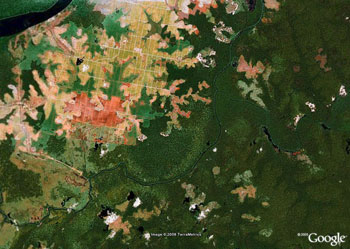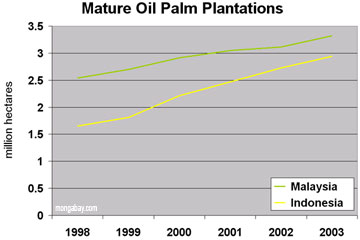Weedy grass could free U.S. of foreign oil says biologist
Weedy grass could free U.S. of foreign oil dependence says biologist
mongabay.com
February 16, 2007
A weedy grass may hold the key to domestic energy security and mitigating emissions of greenhouse gasese, said a Stanford University plant biologist speaking Friday at the annual meeting of the American Association for the Advancement of Science in San Francisco.
Chris Somerville, director of the Carnegie Institution’s Department of Plant Biology, said Miscanthus could be used to produce ethanol at a lower economic and environmental cost than corn, currently the primary source of ethanol usd. in the United States. Miscanthus, a perennial grass native to subtropical and tropical regions of Africa and southern Asia, produces about twice as much biomass per acre without irrigation than other grasses and can be used to generate cellulosic ethanol, a type of ethanol which can be derived from virtually any plant matter. Somerville says that Miscanthus offers the best hope of meeting the ethanol targets set forth by President Bush in his January 23 State of the Union address.
 The above figure from the U.S. Department of Energy explains plant cell wall structure (biomass) and some of the issues preventing their efficient conversion to ethanol. Click here for a full size image with explanation. Last year the DOE announced the goal of making ethanol a practical and cost-competitive alternative by 2012 (at $1.07/gal) and displacing 30% (60 billion gallons) of gasoline by 2030. The United States now produces 4.5 billion gallons of (corn-grain) ethanol per year, a fraction of the 140 billion gallons of transportation fuel used annually. |
“To expand beyond 12 billion gallons, we need to use the body of the plants rather than use the seeds,” Somerville said. Miscanthus “uses less water per gram of biomass produced than other plants.”
He added that Bush’s target of 35 billion gallons of alternative fuels by 2017 is possible but unlikely given current conditions.
“It is certainly possible to achieve Bush’s goals technically,” he said. “The question in my mind is whether investors are ready to put up the money required to make it happen.”
Somerville noted that the main reason for the interest in biofuels was not a supply issue but the impact of continued burning of fossil fuels.
“There are reserves of coal for 200 years at least, and coal can be liquefied into fuel, but it produces an awful lot of CO2,” he explained. Biofuels are generally carbon neutral sources of energy, meaning their growth absorbs as much carbon as is released when they are burned.
Somerville said that environmental concerns over biofuels can be alleviated if they are grown on lands currently used for food production and lands already degraded by deforestation and other activities.
“There’s a lot of deforestation certainly going to take place in tropical regions, because those countries are going to develop biofuel businesses,” he said. “Already in Malaysia, Indonesia, the Philippines, the acreage of palm oil is extending very rapidly because palm oil can be converted to biodiesel with a quite high efficiency and very low capital investment. But is it worse for the environment than climate change? That’s the question.”
“Climate change threatens biodiversity more than anything that I know,” he continued. “For example, in British Columbia they are losing each year forests the size of Rhode Island because of beetle infestation, because it is not cold enough in the winter to kill the beetles, and they are killing the forest.”
Related articles
Why is oil palm replacing tropical rainforests? In a word, economics, though deeper analysis of a proposal in Indonesia suggests that oil palm development might be a cover for something more lucrative—logging. Recently much has been made about the conversion of Asia’s biodiverse rainforests for oil-palm cultivation. Environmental organizations have warned that by eating foods that use palm oil as an ingredient, Western consumers are directly fueling the destruction of orangutan habitat and sensitive ecosystems.
Cellulosic ethanol fuels environmental concerns. In recent months, high fuel prices and national security concerns have sparked interest in biofuels. Cellulosic ethanol, which can be derived from virtually any plant matter including farm waste, looks particularly promising. The U.S. Department of Energy projects that cellulosic conversion technology could reduce the cost of producing ethanol by as much as 60 cents per gallon by 2015. Green groups see cellulosic ethanol as a carbon neutral energy source that could be used to fight the build up of atmospheric carbon dioxide responsible for global warming.
Add invasive species status to list of biofuel concerns. High energy prices over the past couple years have fueled interest in biofuels, which proponents say are less damaging to the environment and provide energy security not afforded by foreign oil and gas imports. Nevertheless, accompanying their rise in visibility, have been concerns over their environmental impact of converting natural vegetation for their production. Now scientists warn that some biofuel crops pose a risk as invasive species.
High oil prices fuel bioenergy push High oil prices and growing concerns over climate change are driving investment and innovation in the biofuels sector as countries and industry increasingly look towards renewable bioenergy to replace fossil fuels. Bill Gates, the world’s richest man, has recently invested $84 million in an American ethanol company, while global energy gluttons ranging from the United States to China are setting long-term targets for the switch to such fuels potentially offering a secure domestic source of renewable energy and fewer environmental headaches
This article is based on a news release from Stanford University .

